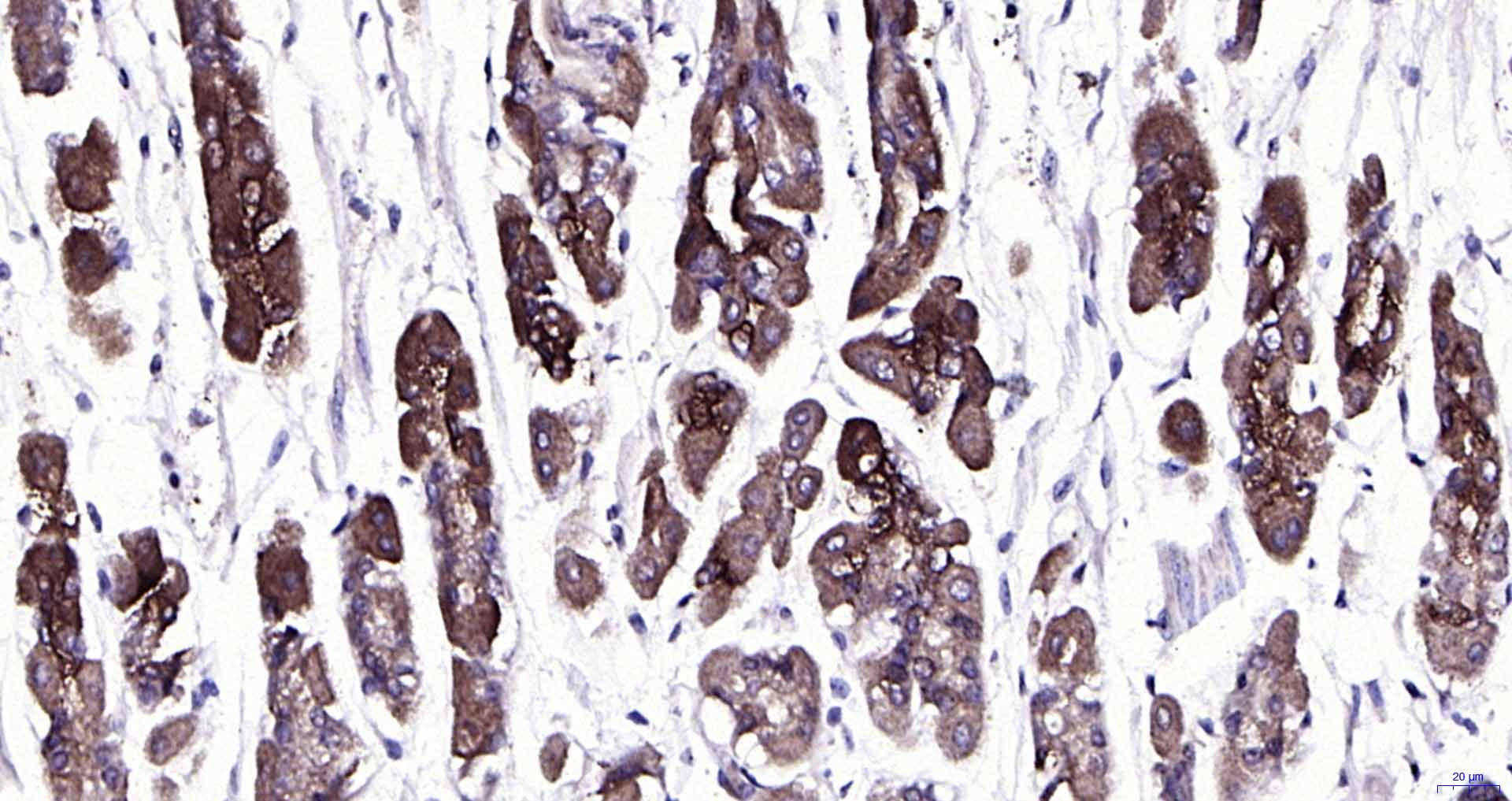FGD3 Rabbit pAb
FGD3 Rabbit pAb
- 产品详情
- 实验流程
- 背景知识
Application
| WB, IHC-P, IHC-F, IF |
|---|---|
| Primary Accession | Q5JSP0 |
| Reactivity | Human, Mouse |
| Predicted | Rat |
| Host | Rabbit |
| Clonality | Polyclonal |
| Calculated MW | 79401 Da |
| Physical State | Liquid |
| Immunogen | KLH conjugated synthetic peptide derived from human FGD3 |
| Epitope Specificity | 501-600/725 |
| Isotype | IgG |
| Purity | affinity purified by Protein A |
| Buffer | 0.01M TBS (pH7.4) with 1% BSA, 0.02% Proclin300 and 50% Glycerol. |
| SUBCELLULAR LOCATION | Cytoplasm. Cytoplasm > cytoskeleton. |
| SIMILARITY | Contains 1 DH (DBL-homology) domain. Contains 1 FYVE-type zinc finger. Contains 2 PH domains. |
| Important Note | This product as supplied is intended for research use only, not for use in human, therapeutic or diagnostic applications. |
| Background Descriptions | FGD1 gene mutations result in faciogenital dysplasia (FGDY, Aarskog-Scott syndrome), an X-linked developmental disorder that adversely affects the formation of multiple skeletal structures. FGD1 maps to human chromosome Xp11.21 and shares a high degree of sequence identity with the FGD2 (6p21.2) and the FGD3 (9q22.31) proteins. FGD1 encodes a guanine nucleotide exchange factor that specifically activates the Rho GTPase Cdc42. FGD2 is present in several diverse tissues during embryogenesis, suggesting a role in embryonic development. FGD3 stimulates fibroblasts to form filopodia, which are Actin microspikes formed upon the stimulation of Cdc42. All FGD family members contain equivalent signaling domains and a conserved structural organization, which strongly suggests that these signaling domains form a canonical core structure for members of the FGD family of RhoGEF proteins. These proteins control essential signals required during embryonic development. |
| Gene ID | 89846 |
|---|---|
| Other Names | FYVE, RhoGEF and PH domain-containing protein 3, Zinc finger FYVE domain-containing protein 5, FGD3, ZFYVE5 |
| Dilution | WB=1:500-2000,IHC-P=1:100-500,IHC-F=1:100-500,IF=1:100-500 |
| Storage | Store at -20 °C for one year. Avoid repeated freeze/thaw cycles. When reconstituted in sterile pH 7.4 0.01M PBS or diluent of antibody the antibody is stable for at least two weeks at 2-4 °C. |
| Name | FGD3 |
|---|---|
| Synonyms | ZFYVE5 |
| Function | Promotes the formation of filopodia. May activate CDC42, a member of the Ras-like family of Rho- and Rac proteins, by exchanging bound GDP for free GTP. Plays a role in regulating the actin cytoskeleton and cell shape (By similarity). |
| Cellular Location | Cytoplasm. Cytoplasm, cytoskeleton |
For Research Use Only. Not For Use In Diagnostic Procedures.
Provided below are standard protocols that you may find useful for product applications.
BACKGROUND
FGD1 gene mutations result in faciogenital dysplasia (FGDY, Aarskog-Scott syndrome), an X-linked developmental disorder that adversely affects the formation of multiple skeletal structures. FGD1 maps to human chromosome Xp11.21 and shares a high degree of sequence identity with the FGD2 (6p21.2) and the FGD3 (9q22.31) proteins. FGD1 encodes a guanine nucleotide exchange factor that specifically activates the Rho GTPase Cdc42. FGD2 is present in several diverse tissues during embryogenesis, suggesting a role in embryonic development. FGD3 stimulates fibroblasts to form filopodia, which are Actin microspikes formed upon the stimulation of Cdc42. All FGD family members contain equivalent signaling domains and a conserved structural organization, which strongly suggests that these signaling domains form a canonical core structure for members of the FGD family of RhoGEF proteins. These proteins control essential signals required during embryonic development.
终于等到您。ABCEPTA(百远生物)抗体产品。
点击下方“我要评价 ”按钮提交您的反馈信息,您的反馈和评价是我们最宝贵的财富之一,
我们将在1-3个工作日内处理您的反馈信息。
如有疑问,联系:0512-88856768 tech-china@abcepta.com.























 癌症的基本特征包括细胞增殖、血管生成、迁移、凋亡逃避机制和细胞永生等。找到癌症发生过程中这些通路的关键标记物和对应的抗体用于检测至关重要。
癌症的基本特征包括细胞增殖、血管生成、迁移、凋亡逃避机制和细胞永生等。找到癌症发生过程中这些通路的关键标记物和对应的抗体用于检测至关重要。 为您推荐一个泛素化位点预测神器——泛素化分析工具,可以为您的蛋白的泛素化位点作出预测和评分。
为您推荐一个泛素化位点预测神器——泛素化分析工具,可以为您的蛋白的泛素化位点作出预测和评分。 细胞自噬受体图形绘图工具为你的蛋白的细胞受体结合位点作出预测和评分,识别结合到自噬通路中的蛋白是非常重要的,便于让我们理解自噬在正常生理、病理过程中的作用,如发育、细胞分化、神经退化性疾病、压力条件下、感染和癌症。
细胞自噬受体图形绘图工具为你的蛋白的细胞受体结合位点作出预测和评分,识别结合到自噬通路中的蛋白是非常重要的,便于让我们理解自噬在正常生理、病理过程中的作用,如发育、细胞分化、神经退化性疾病、压力条件下、感染和癌症。







